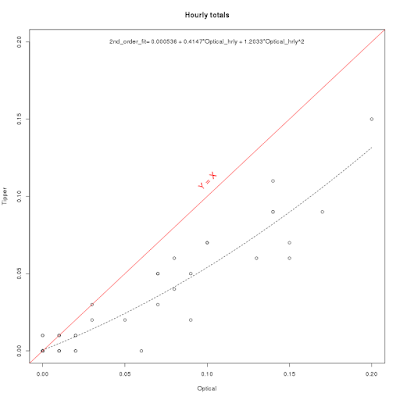As many of you know there are three traditional types of rain gauge, the graduated cylinder rain gauge, the weighing rain gauge, and the tipping bucket rain gauge. All of these types collect or measure the amount of rainfall in some way.
The graduated cylinder is very simple, with a funnel that leads into a narrow cylinder (usually clear), with markings regarding the amount of precipitation.
A weighing gauge determines the rainfall by weighing the amount of water in a bucket:
And then there is the tipping bucket rain gauge in which water fills cups that can only hold .01 inches of rain. When filled, they tip, causing a signal to be sent from a small switch. These gauges need a power source and a device to record the "tips." Tipping bucket gauges are none for "undercatch" during periods of heavy rain, since rain can missed during the tips. They also can have issues with bugs and debris.
But recently, I heard about a new type of rain gauge that doesn't collect water at all. Invented by the Hydreon Corporation, this rain gauge is based on the interactions of infrared beams with water falling on a lens.
Water on the lens allows infrared radiation to escape, which can be sensed by the electronic. This device is relatively inexpensive (about $60) and is related to rain sensors used in cars with automatic wind shield wipers. Interested, I talked to Professor Joel Thornton of my department, who co-teaches the instruments class, and he ordered one. Dr. Thornton gave the unit to some very enthusiastic and capable undergraduates, who got the unit hooked up to a computer and attached a power supply. They will be analyzing the quality of this device's rainfall estimates during the next quarter.
Some of the first results are shown below (courtesy of Neal Johnson of my department). The x-axis shows hourly precipitation from the new unit and the y axis is the amount from a traditional tipping bucket gauge. Not terrible, but the new unit seems to overdo the rainfall for heavier amounts (a perfect match would be found along he red line) We hope to get more of these units and see if we can determine and apply a reasonable calibration to them.
If they can be calibrated, the optical units would be invaluable, particularly in locations where it is not possible to empty or read rain gauges frequently, and where power is not available (power needs are small and could be supplied by batteries). The city of Seattle has purchased about a dozen of these gauges, which will be placed around the city.















Mr. Mass, will you explain the physics behind the light escaping when there is water on the lense?
ReplyDeleteIt is my understanding that a tipping bucket rain gauge tends to under report compared to an official NOAA rain gauge. At least that is what I had a NOAA forecaster tell me some time ago. Would it not be better to compare all three for accuracy? I use a Davis Instruments tipping gauge which does not look as sophisticated as the one depicted on your blog so perhaps it tends to not be as accurate.
ReplyDeleteWith about 30 seconds of effort (following the link Cliff gave us):
ReplyDeletehttp://rainsensors.com/how-it-works/
If you want to go deeper into the physics, Google is your friend...
There is a small grocery store in Sumner that, for many years, had a "weather report rock" on a high shelf outside the store. The instructional sign next to it said something like: "If the rock is wet, it's raining. If the rock is casting a shadow, it's sunny. If you can't see the rock, it's snowed recently."
ReplyDeleteI just installed one on my Raspberry Pi-based station here in Sammamish...
ReplyDeletehttps://personal.xively.com/feeds/632672263
It was a super easy installation and I'd be happy to share code with anyone that wants it!
Frank